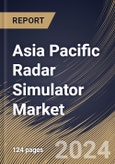Radar simulators are a combination of software and hardware components used for threat emulation and operator training, along with testing radar display systems, offering realism and accuracy. They can generate various modern radar signals and consist of a transmitter, receiver, antenna, and waveform generator, among other sub-components. They provide trainees with the highest level of realism in airborne, weather, maritime, surveillance, ground-based scenarios, air refueling, and mission rehearsal, making them mission-ready.
Numerous factors influence the market, including the emergence of modern warfare systems, the accessibility of simulator training, the rise in defense spending in emergency economies, the demand for efficient and well-informed operators, and the expansion of research and development endeavors in military simulation. Utilizing radar simulators to educate operators on the complexities of contemporary technologies. Aviation professionals may improve their abilities to navigate sophisticated airspace and react to diverse scenarios with the assistance of these simulators, thereby making a beneficial contribution to safety and efficiency.
The Asia Pacific region has seen a significant increase in defense budgets across various countries. Higher defense spending contributes to investments in advanced training technologies, including radar simulators, to ensure that defense personnel are adequately prepared for modern threats. Collaborative efforts and joint military exercises among countries in the Asia Pacific region are common. Therefore, the factors mentioned above will propel the market growth in this region.
The China market dominated the Asia Pacific Radar Simulator Market by Country in 2022, and would continue to be a dominant market till 2030; thereby, achieving a market value of $323.5 Million by 2030. The Japan market is registering a CAGR of 5.5% during (2023 - 2030). Additionally, The India market would experience a CAGR of 6.8% during (2023 - 2030).
Based on Application, the market is segmented into Commercial (Aviation, Automobiles and Others) and Military. Based on Type, the market is segmented into Airborne, Marine, and Ground. Based on Component, the market is segmented into Hardware and Software. Based on Product, the market is segmented into Operator Training and System Testing. The report also covers geographical segmentation of Radar Simulator market. Based on countries, the market is segmented into China, Japan, India, South Korea, Singapore, Malaysia, and Rest of Asia Pacific.
List of Key Companies Profiled
- Mercury Systems, Inc.
- Keysight Technologies, Inc.
- Cadence Design Systems, Inc.
- L3Harris Technologies, Inc.
- RTX Corporation
- Adacel Technologies Limited
- Cambridge Pixel Ltd.
- CAE Inc.
- Aechelon Technology, Inc.
- Buffalo Computer Graphics, Inc.
Market Report Segmentation
By Application- Commercial
- Aviation
- Automobiles
- Others
- Military
- Airborne
- Marine
- Ground
- Hardware
- Software
- Operator Training
- System Testing
- China
- Japan
- India
- South Korea
- Singapore
- Malaysia
- Rest of Asia Pacific
Table of Contents
Companies Mentioned
- Mercury Systems, Inc.
- Keysight Technologies, Inc.
- Cadence Design Systems, Inc.
- L3Harris Technologies, Inc.
- RTX Corporation
- Adacel Technologies Limited
- Cambridge Pixel Ltd.
- CAE Inc.
- Aechelon Technology, Inc.
- Buffalo Computer Graphics, Inc.
Methodology

LOADING...








